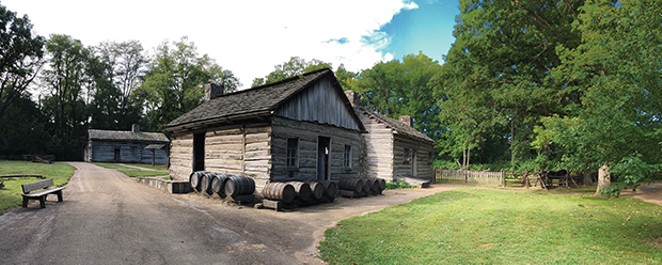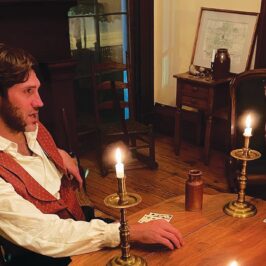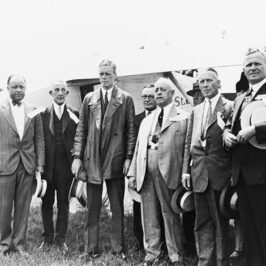May events begin drive for re-restoration
By Cinda Ackerman Klickna

On May 22, New Salem will celebrate the 100th anniversary of an event that occurred on the same date in 1919, many long years after Lincoln had lived in the village, from 1831 to 1837.
It was on May 22 in 1919 that the site was conveyed to the people of Illinois by the owner, William Randolph Hearst. Hearst, a congressman from New York and a wealthy newspaper owner, had purchased the 62-acre site in 1906. The story of how Illinois now has New Salem, that in 2018 was voted the most popular historic site in Illinois, shows that fate can work in interesting ways.
Hearst had been in his hometown of San Francisco helping with recovery from the 1906 earthquake and was traveling back to New York. He had been invited to speak at the New Salem Chautauqua on Aug. 17, 1906. Chautauquas were popular during the 19th and early 20th centuries and drew thousands of people to hear educational lectures, programs, music and entertainment.
While at the New Salem Chautauqua, Hearst decided, or was persuaded, to buy the land where Lincoln had once lived. At the time the area was just a cow pasture with little semblance of the village it has become today; only a few foundations of previous cabins existed. He bought the land for an estimated $12,000 and gave it to the leaders of the Chautauqua. The intent was to restore the area, but nothing occurred for almost 10 years. The agreement had been that if the Chautauqua group did not use the land, it would revert back to Hearst. In 1917 a group formed, the Old Salem Lincoln League. (Its successor organization, the New Salem Lincoln League, formed in 1981). By 1918, money had been raised and a few cabins built; locations of previous cabins were marked. In 1919 the organization received permission from Hearst to give the land to the state of Illinois as a state park.
Now, 100 years later, the Abraham Lincoln Association (ALA), the New Salem Lincoln League, the Department of Natural Resources (DNR), and Looking for Lincoln have joined forces to help restore New Salem through fundraising efforts. They are also lobbying the legislature for New Salem to be included in a capital bill which may emerge from this year’s General Assembly session.
Bob Willard, president of the ALA since 2018, set out several goals for his term. “One of my goals is to rescue New Salem. We started this in honor of the Illinois bicentennial, but we know it will take a long time,” Willard says. “The state is beset with financial problems so we wanted to see what we could do. But one part of the work is to put pressure on the state. Hearst gave the land to the people of the state; they are the real benefactors. The state is the entity that should take care of the site.”
Al Grosboll, past president of the nonprofit New Salem Lincoln League, says, “Back in the early 1930s, the state began the restoration of the village and deserves credit for what they did. Our group has funded over $1 million in projects and pay for volunteer interpreters.” He, too, feels the state has some obligation. Grosboll explains, “The state used to employ 25-30 employees, including interpreters, a carpenter who could do maintenance, etc. There are now only six employees – only one interpreter. Others are volunteers.”
Kathryn Harris, past president of ALA, and Guy Fraker, attorney, author, and expert on Lincoln’s practice as a circuit rider, are now the ALA co-chairs of the project. Harris says, “We want to bring attention to New Salem and the restoration needs. We are calling this the Friend-Raiser Fundraiser. We hope people will contribute to the restoration of cabins as well as the park.”
Fraker says his lifetime interest in New Salem was “kindled when I was 10 years old. Before it is too late, we need to get the restoration and preservation of New Salem on a good footing.”
Indeed, a stroll through New Salem makes it clear that work is needed. Even though the site is still a beautiful place with the many cabins open to visitors and site interpreters telling the history, deterioration is evident. Some chimneys have begun to crumble. Fireplaces are deteriorating. Moss growing on roofs has destroyed shingles. Weather and time have caused beams to sag. One building, known as the Trent barn, is now off limits due to deterioration.
Terry Jones, New Salem assistant manager, says, “New Salem was always meant to be a memorial to Abraham Lincoln. For 100 years it has been a place of inspiration – people can walk where he walked in the context of what it looked like when he lived here. We want to help make sure that we can keep inspiring for the next 100 years.”
Two unique events – on Saturday, May 18, and on Wednesday, May 22 – are being planned. According to Jones, “On most days, we have a few interpreters in some of the cabins. But on May 18, for the full day, almost all of the cabins will be open with an interpreter in each.”
The May 22 event, held on the actual anniversary of the date Hearst conveyed the land to the state, will be an evening program, beginning at 5:30 (remarks to take place around 6:15) inside the Visitors Center. Speakers will highlight the restoration efforts, and light snacks and drink will be available. The village will be open prior to the program so people can enjoy the cabins.
“We know that we can’t raise all the money needed to restore both the inside and outside of cabins,” Harris says. “We also want to bring awareness to the legislature about a need for a capital development bill. We are inviting the governor, and one of our speakers will be the director of the Department of Natural Resources, Colleen Callahan.”
The history of New Salem is rich, and the site attracts students on field trips, scouts on pilgrimages, and tourists from across the world. Fraker says, “New Salem is unique; it is known that Lincoln was transformed during his time there and his impact on the world makes it a place that the state must help preserve and protect.”
The groups working to bring the village back to its glory point to an excerpt from Lincoln’s New Salem, written in 1934 by Benjamin P. Thomas:
“We can picture Lincoln, coming here at twenty-two, an unknown, unschooled youth – clerking in the store, joining the boys in their rough and tumble sports, rapidly establishing himself. We can see him talking, joking, arguing theology, discussing politics, learning to know these people, winning their confidence. We see him studying, developing, rising from laborer to postmaster, surveyor, legislator. We see him when he leaves at twenty-eight and realize that he has found himself.”
Cinda Ackerman Klickna has been a freelance writer since the 1980s and is interested in local history.
For more, including information about how to donate, email SaveNewSalem@gmail.com
New Salem is on Route 97, 2 miles south of Petersburg, and about 20 miles from Springfield. It is open year-round: May through October, daily from 9-6; November through April, Wednesday through Sunday, 9-4. Closed on Thanksgiving, Christmas and New Year’s.






